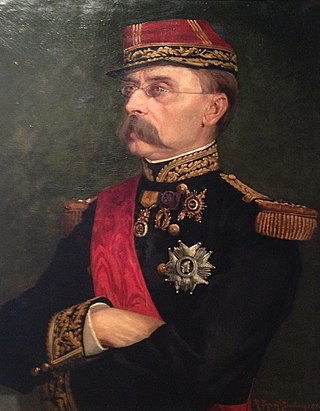Related Research Articles

Dyula is a language of the Mande language family spoken mainly in Burkina Faso, Ivory Coast and Mali, and also in some other countries, including Ghana, Guinea and Guinea-Bissau. It is one of the Manding languages and is most closely related to Bambara, being mutually intelligible with Bambara as well as Malinke. It is a trade language in West Africa and is spoken by millions of people, either as a first or second language. Similar to the other Mande languages, it uses tones. It may be written in the Latin, Arabic or N'Ko scripts.
Zenaga is a Berber language on the verge of extinction currently spoken in Mauritania and northern Senegal by a few hundred people. Zenaga Berber is spoken as a mother tongue from the town of Mederdra in southwestern Mauritania to the Atlantic coast and in northern Senegal. The language is recognized by the Mauritanian government.

Louis Léon César Faidherbe was a French general and colonial administrator. He created the Senegalese Tirailleurs when he was governor of Senegal.

Shawiya, or Shawiya Berber, also spelt Chaouïa, is a Zenati Berber language spoken in Algeria by the Shawiya people. The language's primary speech area is the Awras Mountains in Eastern Algeria and the surrounding areas, including parts of Western Tunisia, including Batna, Khenchela, Sétif, Oum El Bouaghi, Souk Ahras, Tébessa and the northern part of Biskra. It is closely related to the Shenwa language of Central Algeria.

The Chaoui people or Shawia are an Amazigh (Berber) ethnic group to the Aurès region in northeastern Algeria which spans Batna and Khenchla, Oum El Bouaghi provinces located in and surrounded by the Aurès Mountains.

Camille Arambourg was a French vertebrate paleontologist. He conducted extensive field work in North Africa. In the 1950s he argued against the prevailing model of Neanderthals as brutish and simian.

Madghacen, also spelled Medracen or Medghassen or Medrassen or Madghis is a royal mausoleum-temple of the Berber Numidian Kings which stands near Batna city in Aurasius Mons in Numidia, Algeria.
Tetserret is a Western Berber language spoken by the Ait-Awari and Kel Eghlal Tuareg tribes of the Akoubounou (Akabinu) commune in Niger. This main speech area is located between Abalak, Akoubounou and Shadwanka. The variant spoken by the Kel Eghlal is called taməsəɣlalt. The Tamasheq equivalent shin-sart / shin-sar / tin-sar is used in some older literature. Popular understanding among some Ait-Awari derives the name tet-serret, and its Tamasheq equivalent shin-sart, from expressions meaning 'the (language) of Sirte'.

Ethnic groups in Algeria include Arabs and Berbers, who represent 99% of the population, of which 85% are Arab and 15% are Berber. Algeria also has a minority population of Europeans that represents less than 1% of the population. The minority European population is predominantly of French, Spanish, and Italian descent.

Tamazight of Djerba, Chelha of Djerba, or Djerbi is a Berber language of the Eastern Maghreb, spoken on the island of Djerba, in Tunisia. It is a component of what is regularly denominated Tunisian “Chelha”, in the south of the country.
Centre de Recherche Berbère is a department at the Institut national des langues et civilisations orientales (INALCO) specializing in the Berber languages. The center is the oldest organization which focuses on Berber culture and language, being one of the very few to do so. It cooperates with the Institut royal de la culture amazighe du Maroc and programs at Moroccan universities.
Paul Maurice Pallary was a French-Algerian malacologist.
Louis-Fernand Flutre was a French academic.
Émile Masqueray was a 19th-century French anthropologist, linguist, and writer. He was an expert on the Berber–Tuareg peoples of North Africa.
Stéphane Gsell was a French historian and archaeologist. He was a specialist in ancient Africa and Roman Algeria. His main work is L'Histoire ancienne de l'Afrique du Nord (1913-1929).

The Raḥmâniyya is an Algerian Sufi order founded by Kabyle religious scholar Muḥammad ibn ʿAbd al-Raḥman al-Azhari Bu Qabrayn in the 1770s. It was initially a branch of the Khalwatîya established in Kabylia region. However, its membership grew unwaveringly elsewhere in Algeria and in North Africa.
Lucien Camille Golvin was a noted French university professor who specialized in the study of art from the peoples of the Maghreb.
Naïdé Ferchiou was a Tunisian archaeologist whose work dealt mainly with Roman North Africa. She excavated at several important sites, including Abthugni.
Abdellah Bounfour is a Moroccan linguist and philologist specialized in Berber languages, literature and culture. He is an Emeritus University Professor at Institut national des langues et civilisations orientales (INALCO) in Paris.
Nacéra Benseddik is an Algerian historian, archaeologist and epigrapher. She was born in Bordj Bou Arreridj on 4 December 1949.